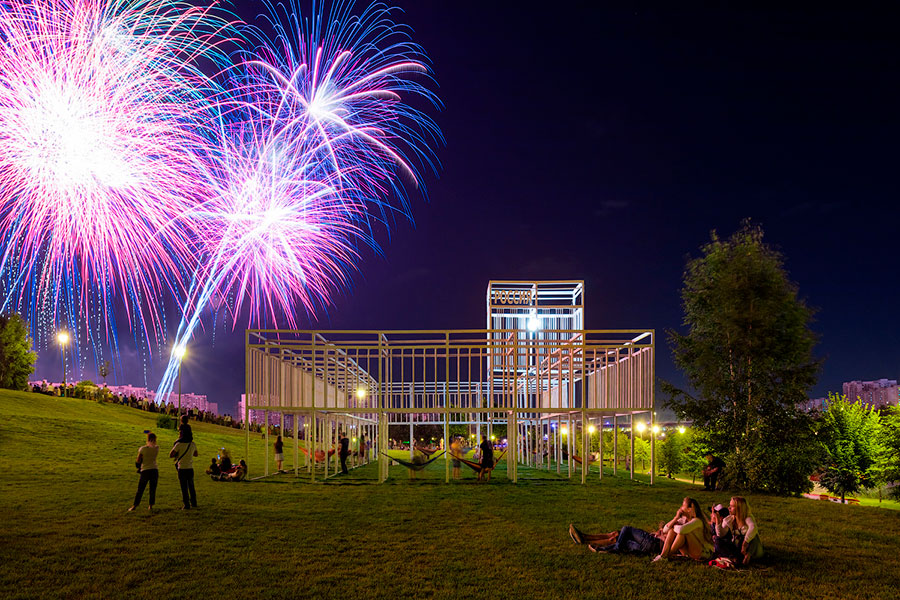Fireworks Festival
Address: Brateevsky cascade park, Moscow, RussiaClient: ROSTECH International Fireworks Festival
Development team
Studio directors: Dmitry Likin, Oleg Shapiro
Chief architect of the project: Eduard Rusenko
Lead architects: Anastasia Izmakova
Architects: Nina Stepina, Alina Malysheva, Kristina Rykova, Ekaterina Kovbashina, Sofya Zhukova, Alina Rakhmatullina, Ekaterina Sporykhina
Project: 2017
Construction: 2017

In the summer of 2017 ROSTECH held an international fireworks festival in the Brateevsky cascade park: for two days the park turned into a playground for holiday festivities. In addition to the fireworks show, a large-scale program was launched in the park which included architectural installations.
To make flagship and iconic objects for the festival event which would divide the territory into different themed zones, served as guides for visitors and at the same time would offer them a variety of recreation.
The young architects of the studio, graduates of the third group of interns under the supervision of lead architect of the studio Anastasia Izmakova came up with the idea of Moscow on the Seven Hills. The symbol of each hill was intentionally chosen from non-obvious associations to preserve the mystery of the place which the visitor would have to find inside the installation. A talk by Philipp Smirnov, a historian on Moscow, helped define each symbol.
As a hint, each object has a description explaining the historical context of the place.
Explanatory notes:
Each installation has a function associated with the historical context of the hill, and in this case, is thematically conditioned by the corresponding zone of the park: the water fountain is next to the food court, the Shvivaya hill next to the craft zone, and one can watch a movie on the Sretensky hill.
BOROVITSKY HILL
The most notable object gives a direct reference to the main Moscow landmarks situated on the Borovitsky hill: the red installation is built as a square behind an abstract fence resembling a burr or a crenellated wall. Huge twelve-meter swings are placed in the centre, which can be used standing up.







The hill received its name in honour of the weavers who lived in this part of the city (on Taganskaya Hill), therefore the symbol of the place was a tower with a vertical loom inside. Five looms with different coloured threads were placed inside the five-pointed star base: an original canvas could be created by anyone on each side by using a shuttle and an additional 'right' rail. The image of the loom is emphasized by decorative threads stretched between the rails.







Movement became the allegory for the hill where Tverskaya Street originates: in 1820 the first diligences went to Tverskaya, in 1872 the first horse-tram was built, later turned into tramways, and in the 1930s several buildings were moved with the expansion of the street. The first film studio in the country was located here:
for the festival, it all turned into a 25-meter route: a platform with built-in rails makes it possible to move seating boxes deeper inside the installation which is completed with a projection of the Tverskaya street perspective view. The backlight used in all objects turned into an artistic gesture hinting both at the nature of cinema and street illumination.





Historically, the Sretensky hill was connected with water: there was a large drinking fountain. There was a large public samovar at the nearby market: a tea-party served as a rite, closing major transactions.
Thus, the symbol of the place was a fountain made of interlacing coloured pipes: the illuminated water circulates throughout the facility and is discharged to the tank using cranes, from which the pipes are then refilled. Since the citizens bought food on the Sretensky hill, the proximity of the fountain with the park food court turned out to be very natural.






Choosing from significant milestones of the Pskovsky Hill - a major trading area, a Jewish ghetto, an English farmstead, we settled on the Soviet biography of this place: the 8th Stalin skyscraper was planned to be constructed right here and later one of the largest hotels in the world, Rossiya, was built on the foundation of the never-completed project. The significant structure was 250 meters long and 150 meters wide, while the main block reached a height of 50 meters.
A relative model of the hotel in a 1:10 scale became the symbol of the Pskovsky Hill: a light wooden structure with a courtyard and a high tower which served as a chill-out zone with hammocks and soft puffs.






The history of the Ivanovskaya hill is associated with music. In 1837, the organ was played for the very first time in the Saints Peter and Paul Cathedral.
It is the image of the musical instrument that formed the basis for the installation. The range of vertical metal pipes of different sizes - a giant organ - produces outlandish sounds: thanks to the stereo effects, each cylinder represents a certain musical instrument and creates its own acoustic environment. There is a xylophone, a harp, a bell, a metallophone, wind instruments, a music box, a disco pipe, a trunk pipe and a sound-absorbing trumpet of silence.








Observations on the Sparrow Hills refer to the construction and engineering achievements associated with the construction of the main building of the Moscow State University, built in the Soviet era. The enormous scale of construction is demonstrated by a star on a spire, reaching the size of 7.5 meters.
It was this star that formed the basis for the installation: a tower of several tiers is formed by a seven-meter star raised vertically several times with a turn. The resulting design resembles the structure of a DNA, referring to the scientific activities of the University. When inside the object, one can see a star in its real size at the bottom of the tower, and a smaller copy above.





